The Octogenarian Who Took on the Shoguns
A tribesman who led a doomed revolt against Japan in 1669 still inspires new generations of Ainu nationalists
![]()
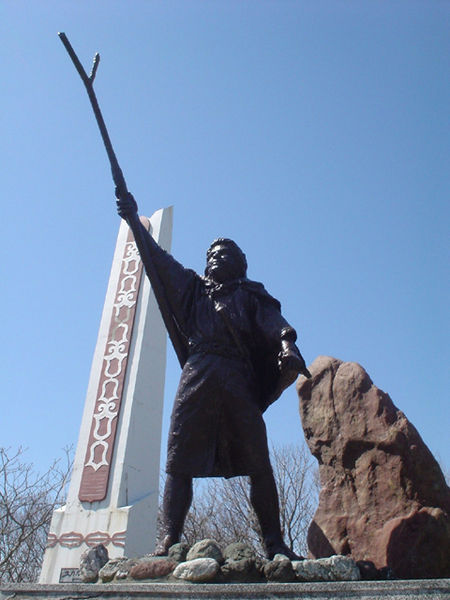
Shakushain, the leader of Ainu resistance to Japan, is shown in this modern memorial on Hokkaido. Thanks to a postwar revival of Ainu nationalism, celebrations of indigenous culture are held each year at this spot. Photo: Wikicommons.
There has always been something otherworldly about Hokkaido. It is the most northerly of the four great land masses that make up Japan, and although separated from the mainland, Honshu, by a strait only a few miles wide, the island remains geologically and geographically distinct. Spiked with mountains, thick with forests, and never more than sparsely populated, it has a stark and wintry beauty that sets it apart from the more temperate landscapes to the south.
Hokkaido is such a familiar feature on maps of Japan that it is easy to forget what a recent addition it is to both the nation and the state. It does not appear in Japanese chronicles until around 1450, and was not formally incorporated into greater Japan until 1869. As late as 1650, the island was known as “Ezo,” and was a distant frontier zone, only tenuously controlled from Edo (modern Tokyo). Even in the 1740s, Tessa Morris-Suzuki notes, maps of the region still showed it “disappearing over the horizon and petering out in a splash of unconvincing islands.” And while it seems always to have possessed a small population of Japanese hunters and merchants, Hokkaido was home to, and for the most part run by, a significantly larger group of indigenous tribes known collectively as the Ainu.
It was not until the 1660s that Japan asserted its dominance over Hokkaido, and when it did it was as a result of one of the most self-evidently doomed rebellions known to history. Shakushain’s revolt, they called it, after the octogenerian Ainu chief who led it, pitting 30,000 or so ill-organized tribesmen against a nation of 25 million, and stone age military technology against the modern firearms of Japan. He lost, of course; just one Japanese soldier died fighting the rebels, and Shakushain himself was ruthlessly assassinated as soon as a peace treaty was signed. But while the Ainu suffered in the short term–enduring an influx of Japanese onto their island, and ever harsher terms of trade–it no longer seems quite so clear who the real victors were in the long run. Today, Shakushain has become an inspiration to new generations of Ainu nationalists.

The furthest extent of Ainu influence in Japan, based on archaeological and place-name evidence. Hokkaido–which is roughly the same size as Ireland–is the large island colored deep red. Map: Wikicommons.
The roots of Shakushain’s revolt lie buried in Japan’s prehistory. The Ainu–the word means “most humanly beings”–are a people of obscure origins whose closest links are with the natives of Siberia. Yet at some point in the distant past there must have been wars between the Ainu and the Japanese, which the Ainu lost. There is evidence, in the form of place-names, that their range once extended deep into the mainland, perhaps even as far south as the latitude of Tokyo itself–but by the first years of the 17th century they were confined to Hokkaido and the Kuril chain, and found themselves under increasing pressure to yield what remained of their commerce to the merchants and the warriors of Japan.
As for the causes of Shakushain’s revolt: There can be no doubt that trade–specifically, Japan’s determination to ensure it got the best of every deal made in Hokkaido–was the trigger. But as tensions on the island rose, threats were made by the outnumbered local Japanese that amounted to promises of genocide. For that reason, the main dispute between historians who study this little-noticed episode revolves around a single question: Is the Ainu’s struggle best be seen as an economic or a racial conflict–or even as a war of independence?
It does not help that the centuries separating the development of an Ainu culture in Hokkaido after 660 from Shakushain’s rebellion in 1669 are only sketchily illuminated, more so by anthropology and archaeology than by the historian’s craft. But it is now generally agreed that the Ainu moshir–”Ainu-land”–remained culturally distinct throughout this period. The Ainu were hunters, not gatherers; they fished for salmon and tracked bear and deer. Religious life centered on shamans and an annual bear festival, during which (it was believed) the divine spirit of a captured bear was freed by sacrificing it. The main exports of Ainu-land were hawks, bears’ livers and dried fish, which were exchanged for metalware, lacquer bowls, sake and the rice that was so hard to grow in northern latitudes. Meanwhile, the Japanese presence on Hokkaido remained almost entirely confined to a tiny enclave on the island’s southernmost promontory.
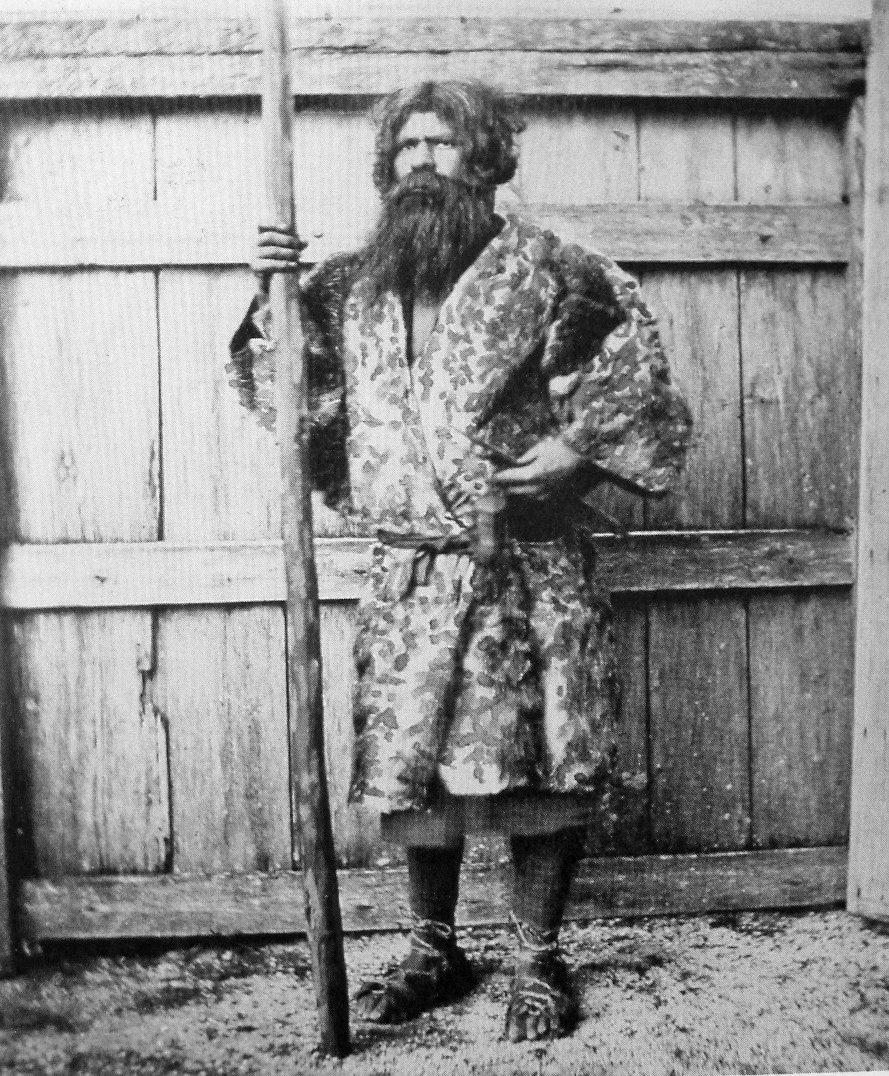
An Ainu man, wearing traditional dress and the abundant beard that distinguished his people from the Japanese, photographed in 1880.
It was only after 1600 that relations between the Ainu and the Japanese reached a tipping point, and Japan became distinctly the senior partner in both diplomacy and trade. The change coincided with momentous events in Honshu. The Tokugawa shogunate, established in 1603, restored peace, stability and unity to the country after more than a century of war and civil war; the new ruling family shifted the capital to Edo (now Tokyo), thoroughly reorganized the feudal system, and suppressed Christianity. The mid-1630s saw the introduction of the policy of sakoku–which may be roughly translated as “locking the country”–under which practically all trade with the outside world was prohibited, foreigners were expelled from Japan, and others were forbidden, on pain of death, from entering imperial territory. The Japanese were not permitted to leave, and trade with the outside world was permitted only through four “gateways.” One of these was Nagasaki, where Chinese vessels were cautiously admitted and the Dutch were permitted to unload a handful of vessels annually on an artificial island in the harbor. Another, on Tsushima, conducted business with Korea; a third was located in the Ryukyu Islands. The fourth gateway was the Japanese enclave on Hokkaido, where trade was permitted with Ainu-land.
Sakoku, the historian Donald Keene notes, exacerbated a Japanese tendency
to see foreigners (and particularly Europeans) as a special variety of goblin that bore only superficial resemblance to a normal human being. The usual name given to the Dutch was komo or “red hairs,” a name intended more to suggest a demonic being than to describe the actual coloring of the foreigners’ hair. The Portuguese had also at one time been declared by the shogunate to possess “cat’s eyes, huge noses, red hair and shrike’s tongues.”
The Ainu, likewise, were objects of suspicion. They were typically shorter and stockier than most Japanese, and had considerably more body hair. Ainu men cultivated long beards, a most un-Japanese trait. They were also not disposed to yield to increasing pressure from the south. There was fighting between the Ainu and the Japanese in 1456-57 (an outbreak known as “Koshamain’s rebellion“), from 1512 until 1515, and again in 1528-31 and 1643. In each case, the issue was trade. And each time, the Ainu lost.
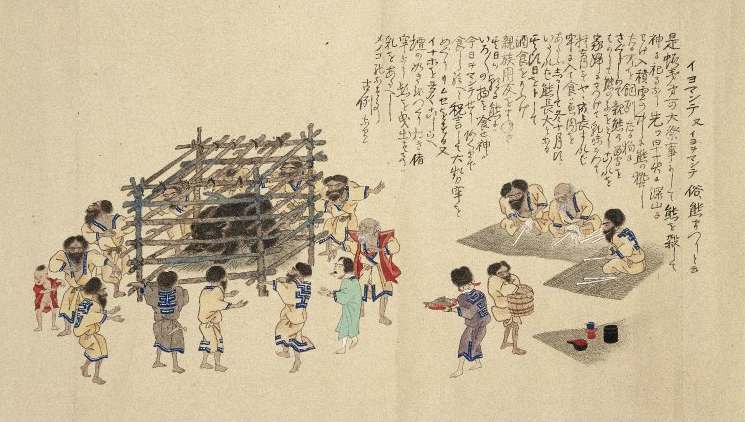
The Ainu illustrated with a captured bear in the Ezo Shima Kikan (“Strange Views from the Island of Ezo”), a set of three scrolls dating to 1840 that are now in the Brooklyn Museum. Click twice to view in higher resolution.
This growing imbalance of power accelerated after 1600. By then, the Japanese had firearms in the shape of matchlock muskets, which they had acquired from the Portuguese, while the Ainu still depended on spears and bows and arrows. Japan had also become a unified state at a time when the people of Hokkaido still lived in warring tribal groupings, lacking (Shinʼichirō Takakura notes) an economy large enough to support any “permanent political organization”–or, indeed, a standing army. The largest Ainu polity of the 17th century was only 300 people strong.
The shogun’s authority, admittedly, was not absolute. Rather, it was exercised through several hundred daimyo–feudal lords who lived in castles, collected taxes and maintained order in their districts with the help of samurai. For the most part, the daimyo maintained a sort of semi-independence that became more entrenched the further from the capital they were based. Certainly Japan’s representatives in the northernmost parts of Honshu, the Matsumae clan, were reluctant to invite interference from Edo, and a missionary who visited their territory in 1618 was curtly informed that “Matsumae is not Japan.”
Japan’s feudal system helped to shape the course of Shakushain’s revolt. Matsumae was the smallest and the weakest of all Japan’s lordships. It could muster only 80 samurai, and, uniquely among all the daimyo, lived by trade rather than agriculture. Matsumae imported the rice it needed from the south, and the Ainu were, thus, vital to its survival; the trade in hawks alone–sold on to other daimyo further to the south–accounted for half the clan’s annual revenues. It was the urgent need to make money that led Matsumae to carve out an enclave north of the Tsugaru Strait, which was ruled from Fukuyama Castle. The creation of this small sliver of Japan in Hokkaido was, in turn, the proximate cause of the Ainu rebellion, and had Shakushain confronted only Matsumae, it is possible that his people might have triumphed by sheer weight of numbers. As it was, however, the shogunate was unwilling to tolerate the possibility of military defeat. Two neighbouring daimyo were ordered to go the Matsumae’s aid, and it is thanks to the records kept by one of them that we have a tolerably independent account of what transpired on Hokkaido in the 1660s.

Fukuyama Castle, on the Tsugaru Straits, was the main base of the Matsumae, the Japanese lords responsible for guarding the northern frontiers of the shogunate from Russian and Ainu incursions. The current structure dates from the mid-19th century but was built in traditional style. The castle known to Shakushain would have looked much the same.
As late as the 1590s, Hokkaido’s natives had retained almost complete control over the resources of their island; they caught hawks, speared fish, shot deer and trapped bears, paddled their canoes to Japanese ports, and there chose the merchants to whom they were prepared to sell their salmon, furs and birds of prey. The trade was quite profitable. “Many Ainu families,” Morris-Suzuki says, “acquired collections of lacquer-ware and Japanese swords which would have been far beyond the reach of the average Japanese farmer.”
All this changed, though, in the 17th century. First gold was discovered on Hokkaido in 1631, leading to a rapid influx of Japanese miners and the establishment of mining camps in the island’s interior–the first time that any Japanese had settled there. These incomers were not policed by Matsumae, and behaved toward the Ainu as they pleased. Then, in 1644, the shogunate granted Matsumae a monopoly over all trade with Hokkaido. This was a catastrophic decision from the Ainu point of view, since–by dealing selectively with several daimyo–they had hitherto managed to keep the prices of their products high. Matsumae wasted no time in exploiting its new rights; after 1644, Ainu canoes were forbidden to call at Japanese ports. Instead, Matsumae merchants began setting up fortified trading bases on Hokkaido itself, from which they made take-it-or-leave-it offers to buy what they wanted.
Some Ainu resisted, advocating a retreat to the interior and a return to their traditional way of life. But the lure of imported rice and metal was too much. Trade therefore continued on the new terms, and it was not long before the situation deteriorated further. Matsumae began netting the mouths of rivers, catching salmon before they could ascend to the spawning grounds where the Ainu speared them. The islanders were also angered to discover that Matsumae had unilaterally changed the exchange rate for their goods. As one chieftain complained:
Trading conditions were one sack of rice containing two to for five bundles of dried salmon . Recently they have started giving us only seven or eight sho of rice for the same amount of fish. Since we people have no power of refusal we are obliged to do as they please.

Matsumae. Four samurai from Japan’s most northerly daimyo, sketched in 1856. The clan retained a tenuous semi-independence from the shogunate, but was forced to accept help from the central government during Shakushain’s revolt.
This combination of lower prices and fewer resources quickly caused a crisis in Ainu-land. By the 1650s, tribes along Hokkaido’s eastern coast, where most of Matsumae’s trading forts were located, had begun to turn upon one another. This sporadic warfare encouraged dozens of small communities scattered along the banks of Hokkaido’s rivers to coalesce. By 1660 there were several powerful chieftains on the island, and of these, the two greatest were Onibishi (who led a confederation known as the Hae) and Shakushain, who as early as 1653 ruled over the Shibuchari. The two men lived in villages only eight miles apart, and there had been rivalry between them for years; Onibishi’s father had fought with Shakushain’s, and Shakushain’s immediate predecessor had been killed by Onibishi. Shakushain’s tribe was the larger, but gold had been found on Onibishi’s land, and Matsumae thus favored the Hae.
Little is known of Shakushain himself. The one Japanese eyewitness to describe him wrote that he was “about 80 years old, and a really big man, about the size of three ordinary men.” But most historians of the period trace the origins of his revolt to sporadic conflict between the Hae Ainu and the Shibuchari that began as early as 1648 and came to a head in 1666, when Shakushain’s tribe committed the unforgivable sin of refusing to provide a cub for sacrifice by the Hae during the annual bear festival. The plea that Onibishi made on this occasion reflects decades of gradually worsening economic prospects: “My land is very unhappy, as we have not been able to capture even one bear.”
The increasing scarcity of resources probably explains the determination of both Ainu tribes to prevent poaching on their territory, and this escalated the conflict. In the summer of 1667, a Hae Ainu hunter related to Onibishi ventured onto Shakushain’s land and trapped a valuable crane. When the trespass was discovered, the hunter was killed, and when Onibishi demanded 300 tsugunai (compensatory gifts), Shakushain sent a miserly 11.
The result was what amounted to a blood feud. The Shibuchari raided their neighbors, killing two of Onibishi’s brothers; soon, Onibishi and his remaining men were surrounded in a Japanese mining camp. Shakushain gave the order to attack, and Onibishi was killed and the camp burned to the ground. The Hae retaliated in kind, but in July 1668 their main fortress fell and the Ainu’s civil war was over.
Shakushain must have realized that by attacking a Matsumae mining camp he was in effect declaring war on Japan, but his defeat of the Hae opened up fresh possibilities. The Shibuchari followed up their victory by assembling a coalition of other Ainu tribes that they hoped would be strong enough to resist the inevitable counterattack. Many Ainu were feeling so desperate by the late 1660s that the members of 19 eastern tribes were willing to set aside their differences and form a formidable coalition that probably mustered at least 3,000 fighting men.

Hokkaido in 1669, showing the sites at which nearly 300 Japanese traders and seamen were massacred. Shakushain ruled over the territory marked “Menashikuru.” The main battle site associated with the revolt, Kunnui, is shown to the left on the island’s southern peninsula. Note how limited the extent of the Matsumae lands was at this point–Japanese territory amounted to less than 4 percent of the land area of the island. Map: Hideaki Kiyama.
What set Shakushain apart from other Ainu rebels is what he did with the force he had assembled. Ainu resistance hitherto had been almost entirely defensive; the odd arrogant merchant might be ambushed and killed, but the Ainu seem to have recognized the likely futility of launching an all-out attack on the Japanese. In June 1669, however, Shakushain decided to ignore the lessons of history. He ordered an attack on all the isolated mining camps, Matsumae trading forts and Japanese merchant ships in Hokkaido–and it says much for the Ainu’s improving organization, and his own standing as a leader, that the result was a well coordinated assault that rained down destruction all along Hokkaido’s coasts.
More than 270 Japanese died in the attacks, and 19 merchant ships were destroyed. Half the coast was devastated, and only about 20 of the Japanese living outside Matsumae’s enclave on Hokkaido survived the massacres. Once word got out, officials at Fukuyama Castle were faced with general panic among the merchants and civilians living in the enclave.
It was only at this point that Matsumae seems to have realized that things were getting out of hand in Ainu-land. The destruction of the mining camp was not only a blow to trade and a direct challenge to the clan’s assumed supremacy in Hokkaido; the mustering of a substantial Ainu army also represented a genuine threat to its security. That Matsumae was forced–albeit reluctantly–to report the disasters of 1669 to Edo and accept help from the neighboring daimyo seems proof that the position was considered serious. The first preparations for war, moreover, show how uncertain the Japanese were of their position; a good deal of effort was plowed into the construction of defensive positions, and there seems to have been no thought yet of taking the offensive.
Meanwhile, Shakushain did his best to retain the initiative. An Ainu army advanced south and covered about half the distance to Fukuyama Castle before it encountered an advance guard of Japanese troops near Etomo. A few days later the two forces met further south, at Kunnui, but poor weather and high rivers dented the Ainu assault. When Shakushain’s men came under sustained musket fire from the Matsumae’s samurai, they were forced to retreat. This skirmish proved to be the main engagement of the war.
The Japanese army was not large; at first it was only 80 strong, and even after reinforcements arrived from other daimyo in northern Honshu it numbered no more than 700. In terms of arms and armor, though, Matsumae’s advantage was decisive. As “peasants,” the Ainu had no right to bear arms in feudal Japan. Their most effective weapons were aconite-tipped poison arrows, which they made by dipping arrowheads first in fir resin and then in a bowl of dried, ground wolfsbane. These arrows had long caused consternation among the Japanese, who expended significant effort, unsuccessfully, to uncover the secret of their manufacture. In action, however, they proved ineffective, since the Ainu’s under-powered bows were unable to penetrate samurai armor, or even the cotton-wadded jackets worn by ordinary foot-soldiers.
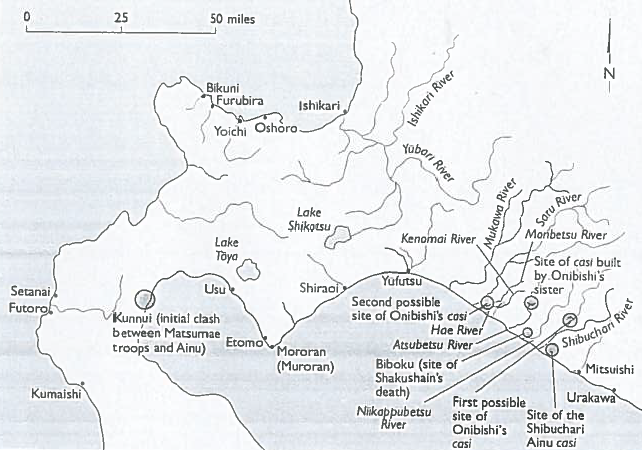
Map showing the main sites linked to Shakushain’s revolt. From Brett Walker’s The Conquest of the Ainu Lands.
With Shakushain now in retreat, the revolt was ended a month or so later by the arrival of substantial reinforcements from Honshu. Counterattacks burned a large number of Ainu forts and canoes, and by October, Shakushain had been surrounded; at the end of that month, he surrendered. The Ainu threat was ended shortly thereafter when, at a drinking party held to celebrate peace, an old Matsumae samurai named Sato Ganza’emon arranged the murder of the unarmed Shakushain and three other Ainu generals. “Being unable to fight back,” an eyewitness reported, “Shakushain arose gave a big glare in all directions, shouting loudly, ‘Ganza’emon, you deceived me! What a dirty trick you pulled.’ squatted on the ground like a statue. Keeping this posture, Shakushain was killed without moving his hands.” The Shibuchari’s main fortress was then burned down.
Even so, it took three years for Matsumae to complete the pacification of Ainu-land, and although the outcome was scarcely in doubt, it was nonetheless a compromise. The peace treaty bound the Ainu to swear allegiance to Matsumae and to trade solely with the Japanese. There was a considerable expansion in the Japanese presence in the far north, and soon 60 new Matsumae trading posts were operating in Hokkaido, driving such hard bargains that several Ainu settlements were reported to be on the verge of starvation. On the other hand, the Ainu retained formal autonomy through most of their island, and even won some important concessions on the rice-fish exchange rate that had sparked the uprising in the first place.
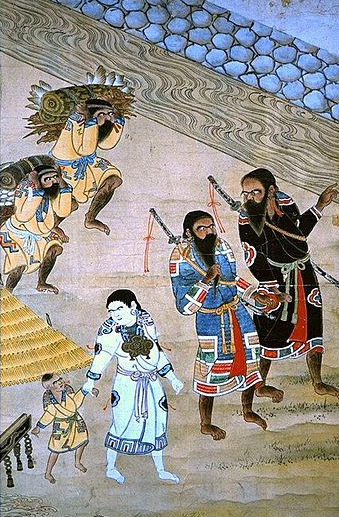
Ainu arrive at one of the new customs posts established after Shakushain’s revolt to allow Japan to control trade in Hokkaido.
Why, though, murder Shakushain? His forces had been defeated; it was clear that, even united, the Ainu were no match for the armies of the northern daimyo, much less a threat to Japan itself. The answer seems to lie in the shogunate’s sketchy knowledge of the outside world–a problem that must surely have been exacerbated by the sakoku edits of the 1630s. Brett Walker explains that the Japanese were swayed by fantastic rumors that the Ainu had established an alliance with a much more dangerous “barbarian” kingdom, the Tatars of Orankai, who wielded power in southern Manchuria; for a while there seemed to be a threat that they and the Jurchens might combine forces and lead an invasion of Japan that would succeed where Kublai Khan had failed four centuries earlier. For Edo, this must have seemed no empty threat; another northern people, the Manchus, had only recently completed their conquest of China, overthrowing the Ming dynasty.
Certainly relations between Japan and Ainu-land shifted fundamentally after 1669. Thenceforth, while the Ainu retained much of their old de facto independence, it was rendered increasingly worthless by the de jure peace settlement they had signed. ”What is clear from the historical record,” writes Danika Medak-Saltzman, “is that what was once a relationship of mutual exchange…turned into a system of tribute and then into a trade monopoly.” The Ainu were compelled to sell what they had–both goods and labor–at prices determined by the Japanese. Their canoes no longer appeared in Honshu ports, and those unable to support themselves by hunting were compelled to work as what amounted to forced labor in fish-processing plants on the mainland at about a seventh of the rate paid to Japanese.
The thing that made the greatest difference, though, was the ever-widening gap between Japan’s perception of the Ainu and its perception of itself. After 1854, Medak-Saltzman notes–when Japan was forced by a U.S. Navy squadron to reopen its frontiers–its government was prone to see Hokkaido as the Japanese equivalent of the American Wild West, complete with its own “Indian problem.” It took only the few weeks of Shakushain’s revolt to cement this reputation; it has taken the best part of two more centuries to dispel it, and for Ainu history to be perceived as something worth studying in its own right.
Sources
Stuart Eldridge. “On the arrow poison in use among the Ainos of Yezo.” In Transactions of the Asiatic Society of Japan 4 (1888); David Howell. Capitalism From Within: Economy, Society and the State in a Japanese Fishery. Berkeley: University of California Press, 1995; Kiyama Hideaki. “Shakushain’s Revolt of 1669: A Study of a War between the Ainu and the Japanese.” In Bulletin of the College of Foreign Studies I (1979); Donald Keene. The Japanese Discovery of Europe: 1720-1830. Stanford: Stanford University Press, 1969; Danika Fawn Medak-Saltzman. Staging Empire: The Display and Erasure of of Indigenous Peoples in Japanese and American Nation-Building Projects (1860-1904). Unpublished University of California, Berkeley PhD dissertation, 2008; Tessa Morris-Suzuki. “Creating the Frontier: Border, Identity, and History in Japan’s Far North.” In East Asian History 7 (1994; Sir George Sansom. A History of Japan to 1334. Stanford: Stanford University Press, 1958 Richard Siddle. Race, Resistance and the Ainu of Japan. London: Routledge, 1996; Tom Svensson. “The Ainu.” In Richard B. Lee and Richard Daly (eds). The Cambridge Encyclopedia of Hunters and Gatherers. Cambridge: CUP, 1999; Shinʼichirō Takakura. “The Ainu of northern Japan: a study in conquest and acculturation.” In Transactions of the American Philosophical Society 50 (1960); Brett Walker. The Conquest of the Ainu Lands: Ecology and Culture in Japanese Expansion. Berkeley: University of California Press, 2006; Brett Walker, “Foreign affairs and frontiers in early modern Japan: a historiographical essay.” In Foreign Affairs & Frontiers, 2002.
/https://tf-cmsv2-smithsonianmag-media.s3.amazonaws.com/accounts/headshot/mike-dash-240.jpg)
/https://tf-cmsv2-smithsonianmag-media.s3.amazonaws.com/accounts/headshot/mike-dash-240.jpg)